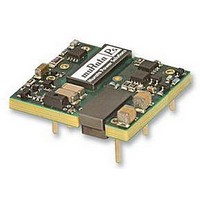UEI15-120-Q12N-C Murata Power Solutions Inc, UEI15-120-Q12N-C Datasheet - Page 7

UEI15-120-Q12N-C
Manufacturer Part Number
UEI15-120-Q12N-C
Description
CONVERTER, DC/DC, 12V, 1.3A
Manufacturer
Murata Power Solutions Inc
Series
UEI15r
Specifications of UEI15-120-Q12N-C
No. Of Output Channels
1
Input Voltage
9V To 36V
Power Rating
15.6W
Output Voltage
12V
Output Current
1.3A
Supply Voltage
24V
Dc / Dc Converter Case Style
Through Hole
Isolation Voltage
2.25kV
Product
Isolated
Output Power
15.6 W
Input Voltage Range
9 V to 36 V
Input Voltage (nominal)
24 V
Number Of Outputs
1
Output Voltage (channel 1)
12 V
Output Current (channel 1)
1.3 A
Package / Case Size
0.96 in x 1.1 in x 0.32 in
Output Type
Isolated DC/DC Converters
Lead Free Status / RoHS Status
Lead free / RoHS Compliant
ances between the power supply and its load. In order to minimize circuit errors
and standardize tests between units, scope measurements should be made using
BNC connectors or the probe ground should not exceed one half inch and soldered
directly to the fixture.
Floating Outputs
Since these are isolated DC/DC converters, their outputs are “floating” with
respect to their input. The essential feature of such isolation is ideal ZERO
CURRENT FLOW between input and output. Real-world converters however do
exhibit tiny leakage currents between input and output (see Specifications).
These leakages consist of both an AC stray capacitance coupling component
and a DC leakage resistance. When using the isolation feature, do not allow
the isolation voltage to exceed specifications. Otherwise the converter may
be damaged. Designers will normally use the negative output (-Output) as
the ground return of the load circuit. You can however use the positive output
(+Output) as the ground return to effectively reverse the output polarity.
Minimum Output Loading Requirements
These converters employ a synchronous rectifier design topology. All models
regulate within specification and are stable under no load to full load condi-
tions. Operation under no load might however slightly increase output ripple
and noise.
Thermal Shutdown
To prevent many over temperature problems and damage, these converters
include thermal shutdown circuitry. If environmental conditions cause the
temperature of the DC/DC’s to rise above the Operating Temperature Range
up to the shutdown temperature, an on-board electronic temperature sensor
will power down the unit. When the temperature decreases below the turn-on
threshold, the converter will automatically restart. There is a small amount of
hysteresis to prevent rapid on/off cycling. The temperature sensor is typically
located adjacent to the switching controller, approximately in the center of the
unit. See the Performance and Functional Specifications.
In figure 3, the two copper strips simulate real-world printed circuit imped-
Figure 3 – Measuring Output Ripple and Noise (PARD)
C1 = 0.1µF CERAMIC
C2 = 10µF TANTALUM
LOAD 2-3 INCHES (51-76mm) FROM MODULE
C1
COPPER STRIP
COPPER STRIP
C2
SCOPE
www.murata-ps.com
R
LOAD
shut down suddenly without warning. Be sure to thoroughly test your applica-
tion to avoid unplanned thermal shutdown.
Temperature Derating Curves
The graphs in the next section illustrate typical operation under a variety of
conditions. The Derating curves show the maximum continuous ambient air
temperature and decreasing maximum output current which is acceptable
under increasing forced airflow measured in Linear Feet per Minute (“LFM”).
Note that these are AVERAGE measurements. The converter will accept brief
increases in temperature and/or current or reduced airflow as long as the aver-
age is not exceeded.
itself which is obviously running at higher temperature than the outside air.
Also note that very low flow rates (below about 25 LFM) are similar to “natural
convection”, that is, not using fan-forced airflow.
with calibrated airflow. We use both thermocouples and an infrared camera
system to observe thermal performance. As a practical matter, it is quite diffi-
cult to insert an anemometer to precisely measure airflow in most applications.
Sometimes it is possible to estimate the effective airflow if you thoroughly un-
derstand the enclosure geometry, entry/exit orifice areas and the fan flowrate
specifications. If in doubt, contact MPS to discuss placement and measurement
techniques of suggested temperature sensors.
the converter may have an unplanned Over Temperature shut down. Also, these
graphs are all collected at slightly above Sea Level altitude. Be sure to reduce
the derating for higher density altitude.
Output Overvoltage Protection
This converter monitors its output voltage for an over-voltage condition using
an on-board electronic comparator. The signal is optically coupled to the pri-
mary side PWM controller. If the output exceeds OVP limits, the sensing circuit
will power down the unit, and the output voltage will decrease. After a time-out
period, the PWM will automatically attempt to restart, causing the output volt-
age to ramp up to its rated value. It is not necessary to power down and reset
the converter for the this automatic OVP-recovery restart.
the OVP circuitry will initiate another shutdown cycle. This on/off cycling is referred
to as “hiccup” mode. It safely tests full current rated output voltage without damag-
ing the converter.
Output Fusing
The converter is extensively protected against current, voltage and temperature
extremes. However your output application circuit may need additional protec-
tion. In the extremely unlikely event of output circuit failure, excessive voltage
could be applied to your circuit. Consider using an appropriate fuse in series
with the output.
CAUTION: If you operate too close to the thermal limits, the converter may
Note that the temperatures are of the ambient airflow, not the converter
MPS makes Characterization measurements in a closed cycle wind tunnel
CAUTION: If you routinely or accidentally exceed these Derating guidelines,
If the fault condition persists and the output voltage climbs to excessive levels,
Isolated Wide Input Range 15-Watt DC/DC Converters
Technical enquiries email: sales@murata-ps.com, tel:
UEI15 Series
MDC_UEI15W.B12 Page 7 of 12
+1 508 339 3000




















